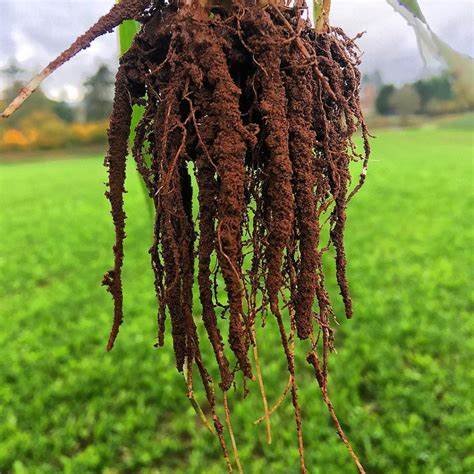Working with Nature
By Craig Madsen
Diagram of nutrient cycling
Are you getting your money’s worth out of synthetic fertilizer? Before discussing ways to increase the effectiveness of your synthetic fertilizer application, it is important to develop a better understanding of how a natural system functions without it.
Have you heard of Plant Growth Promoting Rhizobacteria? Mycorrhizal Fungi? Do you know about the impact of earthworms on plant productivity? If you have planted legumes before, you have inoculated your seed with rhizobia, a bacteria that fixes nitrogen after becoming established inside the root nodules of legumes. These organisms and others play a significant role in healthy soil and the health of plants, animals, and the humans who consume them.
In this article, we will discuss the various roles of some of the organisms and their potential impact on plant productivity.
Rhizosheath
Rhizobacteria
Plant growth-promoting rhizobacteria are root-associated bacteria that live either inside the root or in close proximity. These organisms have a relationship with the plant. The plant provides a food source through root exudates, and the organisms provide various nutrients and other compounds that help the plant manage environmental stress and provide protection for the plant.
What role do growth-promoting rhizobacteria play?
Fix nitrogen; these free-living bacteria are different than the rhizobia found on legumes.
Solubilize phosphate, potash (potassium), and zinc.
Form siderophores that bind to iron, making iron more available to plants.
Phosphate
Phosphate is a nutrient that can be quickly tied up when applied to the soil. Water-soluble forms of phosphorus are not very stable and react with iron, aluminum, and calcium in the soil to form insoluble compounds that are not readily available to the plant. As a result, only 5 to 30% of the water-soluble phosphorus applied is used by the plant in the year after application. In more acidic soils, soils with a pH of less than 5, the ability of the soil to bind phosphorus increases significantly. Phosphate-solubilizing bacteria and/or mycorrhizal fungi are necessary to break these bonds and make phosphorous available to the plant.
To find out how much phosphorus is in your soil, run a Total Nutrient Digestion soil test. There is a good chance you have adequate phosphorus in your soil but in a form that is not available to the plants. Total Nutrient Digestion provides you with the nutrient potential of your soil (Soil Health Analysis – Regen Ag Lab, LLC).
Mycorrhizal Fungi
Mycorrhizal fungi play many roles in the soil ecosystem and are found on the roots of about 80% of plant species. Their contributions include the following:
Help the plant absorb water and nutrients by increasing the surface area of the plant roots up to 40 times. The small hyphae can access pore spaces in the soil that are too big for the root hairs.
Provide a protective layer around the roots that protects the roots from harmful bacteria and fungi.
Produce antimicrobial compounds that protect the plant from harmful pathogens.
Produce glomalin, which acts as a water-repellent glue that creates macroaggregates and helps the soil maintain its structure when saturated.
Modulate plant hormones such as abscisic acid and salicylic acid, which help the plant deal with environmental stresses such as salinity.
Other fungi produce acids that dissolve rocks and break bonds, making nutrients available to the plants in exchange for root exudates. Others produce antibiotics.
Earthworms
Another great worker in the soil is the earthworm. Earthworm castings compared to undigested soil have:
5 times more plant-available nitrogen
3-7 times more phosphorous
11 times more potassium
3 times more magnesium
-45 earthworms per 8-inch cube of soil through death can provide up to 40 pounds of nitrogen per acre.
Impacts
What are the overall impacts of these plant growth-promoting organisms?
Increase nutrient availability by up to 50%. (Adesemoye et al.)
Reduce the incidence of plant disease by up to 40% (Benduzi et al.)
Improve stress tolerance, resulting in 60% increase in survival rate during adverse conditions such as drought. (Karnwal et al.)
Imcrease pasture production by 10 to 30 percent. Earthworms increase plant production: a meta-analysis | Scientific Reports (nature.com)
Nature is truly an amazing system and as we learn more, we realize how much we do not know about the soil beneath our feet. How best do we work with nature? By accentuating the positive impacts and better managing activities that negatively impact a functioning system, including:
Tillage – impacts fungi
Synthetic fertilizers – plants do not need the relationship with soil organisms if the nutrients are provided synthetically
Fungicides or seed treatments – kill fungi
Wormers – kill insects in the soil
Glyphosate – impacts mycorrhizal colonization of the following crop and impacts bacteria growth
Overgrazing – reduces root growth, plant vigor
Positive steps to take, besides avoiding direct damage to the soil ecosystem, include remembering the following principles:
Diversity above ground correlates to diversity below ground.
Actively growing roots provide food for soil biology.
Covered soil provides food and habitat, moderates temperature, and holds moisture.
By reducing management activities that negatively impact living systems and increasing the positive, we can allow nature to provide more inputs, reducing our costs and improving our bottom line.
Craig Madsen has over 30 years’ experience focusing on ecosystem management issues. For the last 20 years he has co-owned and operated Healing Hooves, a vegetation management business using goats. He has been a Certified Educator in Holistic Management since 2001. He was a Range Management Specialist with the USDA Natural Resources Conservation Service for 14 years. He graduated from Nicole Masters CREATE Coaching Program in April 2022. The CREATE Program was a deep dive into soil ecology, the interrelationships between plants, soil biology, and ecosystem function. He is currently a CREATE Fellowship Coach https://integritysoils.com/pages/create-fellowship-coaches. Craig is the current president of Roots of Resilience.


